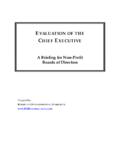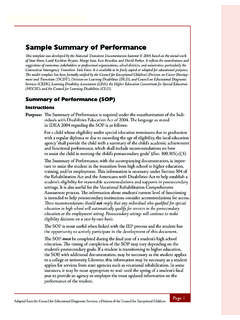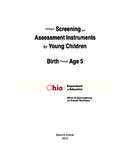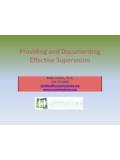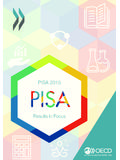Transcription of ASSESSMENT OF INNOVATION CAPACITIES
1 ASSESSMENT OF INNOVATION CAPACITIES A SCORING TOOL OCCASIONAL PAPERS ON INNOVATION IN FAMILY FARMINGOCCASIONAL PAPERS ON INNOVATION IN FAMILY FARMINGFOOD AND AGRICULTURE ORGANIZATION OF THE UNITED NATIONSROME, 2017 ASSESSMENT OF INNOVATION CAPACITIES A SCORING TOOLP repared byChristian GrovermannResearch and Extension UnitFood and Agriculture Organization of the United NationsThe designations employed and the presentation of material in this information product do not imply the expression of any opinion whatsoever on the part of the Food and Agriculture Organization of the United Nations (FAO) concerning the legal or development status of any country, territory, city or area or of its authorities, or concerning the delimitation of its frontiers or boundaries. The mention of specific companies or products of manufacturers, whether or not these have been patented, does not imply that these have been endorsed or recommended by FAO in preference to others of a similar nature that are not views expressed in this information product are those of the author(s) and do not necessarily reflect the views or policies of 978-92-5-109701-4 FAO, 2017 FAO encourages the use, reproduction and dissemination of material in this information product.
2 Except where otherwise indicated, material may be copied, downloaded and printed for private study, research and teaching purposes, or for use in non-commercial products or services, provided that appropriate acknowledgement of FAO as the source and copyright holder is given and that FAO s endorsement of users views, products or services is not implied in any requests for translation and adaptation rights, and for resale and other commercial use rights should be made via or addressed to information products are available on the FAO website ( ) and can be purchased through publication has been printed using selected products and processes so as to ensure minimal environmental impact and to promote sustainable forest photo: Christian GrovermannBack cover photo: FAO/Giulio NapolitanoiiiOCCASIONAL PAPERS ON INNOVATION IN FAMILY FARMINGCONTENTSA cknowledgements.
3 IvCHAPTER 1 INTRODUCTION ..1 CHAPTER 2 CONCEPTUAL BACKGROUND ..3 CHAPTER 3 USING THE TOOL .. STEP-BY-STEP GUIDELINES .. EXAMPLES FROM THE FIELD .. MONITORING AND EVALUATION (M&E) .. CHALLENGES ..15 References ..16 ANNEX 1: CAPACITY SCORING QUESTIONNAIRE ..17 ANNEX 2: NOTES ON PRACTICAL IMPLEMENTATION ..24 ANNEX 3: DATA ANALYSIS SPREADSHEET ..25 ANNEX 4: CD FOR AIS IMPACT OF FIGURESF igure 1: INNOVATION (or systems) CAPACITIES in the TAP Common Framework (TAP, 2016) ..3 Figure 2: Proposed steps in the ASSESSMENT process ..6 Figure 3: Capacity profile (using a CoxComb Plot) of Cassava INNOVATION Partnership in Rwanda ..10 Figure 4: Capacity profiles (using radar plots) of Cassava INNOVATION Partnership in Rwanda showing spread of data (A) and disaggregation by gender (B) ..11 Figure 5: Enabling environment scores (bar charts) for Cassava INNOVATION Partnership in Rwanda.
4 12 Figure 6: Don t Know (DK) and No Opinion (NO) answers by respondents in the Cassava INNOVATION Partnership in Rwanda ..12 Figure 7: Systematic evaluation of INNOVATION capacity ..13 Figure 8: Example of how the CoxComb plot can be used to illustrate capacity changes ..14 LIST OF TABLEST able 1: Overview of indicators used in the capacity scoring questionnaire ..5ivOCCASIONAL PAPERS ON INNOVATION IN FAMILY FARMINGASSESSMENT OF INNOVATION CAPACITIES A SCORING TOOLACKNOWLEDGEMENTSThis document was prepared by Christian Grovermann and reviewed by Karin Nichterlein and Manuela Bucciarelli of FAO s Research and Extension Unit as well Patrick Kalas of FAO s Capacity Development team and Hans Dobson of the Natural Resources Institute, University of Greenwich, UK. The INNOVATION capacity scoring tool has benefitted significantly from the contributions of a number of individuals, who are currently involved in the implementation of the Capacity Development for Agricultural INNOVATION Systems (CDAIS) project.
5 This project is jointly implemented by FAO and Agrinatura in close collaboration with national partners and supports the realisation of the action plan of the Tropical Agriculture Platform1. The author would in particular like to thank Bernard Triomphe (Agrinatura / Cirad), Gilbert Kayitare (FAO Rwanda), Hans Dobson (Agrinatura / Natural Resources Institute), Dalaphone Sihanath (IWMI Lao People s Democratic Republic), Palamy Changleuxay (University of Lao People s Democratic Republic), Oudong Keomiphet (FAO Lao People s Democratic Republic), Patrick d Aquino (Agrinatura / Cirad Lao People s Democratic Republic), Patrick Kalas (FAO Capacity Development Group) and Stephen Rudgard (FAO Lao People s Democratic Republic) for their active role in piloting the version of the tool presented here and for helping to further refine it.
6 In addition to the above mentioned, valuable feedback on the tool was provided by Aurelie Toillier (Agrinatura / Cirad), Karin Nichterlein (FAO) and Myra Wopereis (Agrinatura / ICRA) at various stages of its development. The author would like to also thank all the country level stakeholders for having dedicated their valuable time during the , the author would like thank the German government for funding staff time to develop the tool and travel to piloting it as part of the Associate Professional Officer programme and the European Union, which is providing the majority of the funding for the CDAIS document was designed by Pietro Bartoleschi. The document is available online in the FAO Document Repository2 and PAPERS ON INNOVATION IN FAMILY FARMINGASSESSMENT OF INNOVATION CAPACITIES A SCORING TOOLCHAPTER 1 INTRODUCTIONI nnovative responses to the complex challenges of eradicating hunger, improving rural livelihoods and protecting the environment are needed, if the SDGs are to be achieved.
7 However, no single actor can come up with the solutions that address the wide array of issues that agriculture is faced with today. INNOVATION , be it technological, institutional or social, emerges from collective thinking and action. It as a process by which multiple stakeholders put knowledge to use. Networks of research, extension, producer, agribusiness and other actors as well as the policies, attitudes and behaviours affecting them act as catalysts for INNOVATION . They play a critical role in shaping food systems by generating, documenting, blending, sharing and applying local and scientific knowledge and stimulating learning. INNOVATION presupposes CAPACITIES that make a system function at various levels. For diverse actors to connect, collaborate and learn together effectively within a system, a range of soft skills are essential.
8 INNOVATION CAPACITIES must be upgraded to enhance the results of collective efforts (FAO, 2014a).Assessing INNOVATION CAPACITIES and changes therein is not a straightforward exercise. The literature contributing to the understanding of the role of INNOVATION in agriculture is constantly expanding. Research mostly relies on qualitative analysis ( Hall and Clark, 2010; Klerkx et al. 2010), avoiding more formal methods. However, more structured approaches to assessing INNOVATION processes and CAPACITIES in agriculture have been gaining attention recently (Schut et al., 2015, Sartas et al. 2016). Their potential for providing evidence to decision-makers on gaps and opportunities in terms of capacity development and investment is substantial. Such approaches can also be instrumental in meeting increasingly stringent monitoring and evaluation requirements in projects and programmes.
9 A transition towards sustainable growth in the food and agriculture sectors needs evidence on what works and what does not (OECD, 2011). Well-conceived systematic instruments are key to identifying enabling as well as constraining factors for INNOVATION and ultimately rewarding success. The complexity of determining the CAPACITIES required for facilitating INNOVATION poses challenges in terms of methods and data. Social Network or Timeline analysis are promising instruments in this regard. This document attempts to make a contribution to the growing body of systematic methodologies by explaining the capacity scoring approach elaborated and applied in the context of the Capacity Development for Agricultural INNOVATION Systems (CDAIS) project. CDAIS 2 OCCASIONAL PAPERS ON INNOVATION IN FAMILY FARMINGASSESSMENT OF INNOVATION CAPACITIES A SCORING TOOLis financially supported by the European Union from 2015 to 2018 and jointly implemented in eight countries (Angola, Bangladesh, Burkina Faso, Ethiopia, Guatemala, Honduras, Lao People's Democratic Republic, Rwanda) by national partners, FAO and AGRINATURA, the latter being an alliance of European institutes working on agricultural research for development.
10 The project aims at strengthening INNOVATION partnerships at local level and promoting an agricultural INNOVATION systems perspective at the policy level. It is based on a common approach developed under the Tropical Agriculture Platform (TAP), the so-called Common Framework on Capacity Development for Agricultural INNOVATION Systems (TAP, 2016). TAP is an initiative of the G20 with a mandate to increase the coherence and effectiveness of capacity development interventions for agricultural INNOVATION in the tropics. It has over 40 partners, with FAO hosting its and TAP Partners recognize the crucial importance of needs-based capacity development interventions. At the core of the strategy of the CDAIS project to strengthen the capacity to innovate in eight countries are participatory assessments of existing CAPACITIES as well as capacity development needs.












